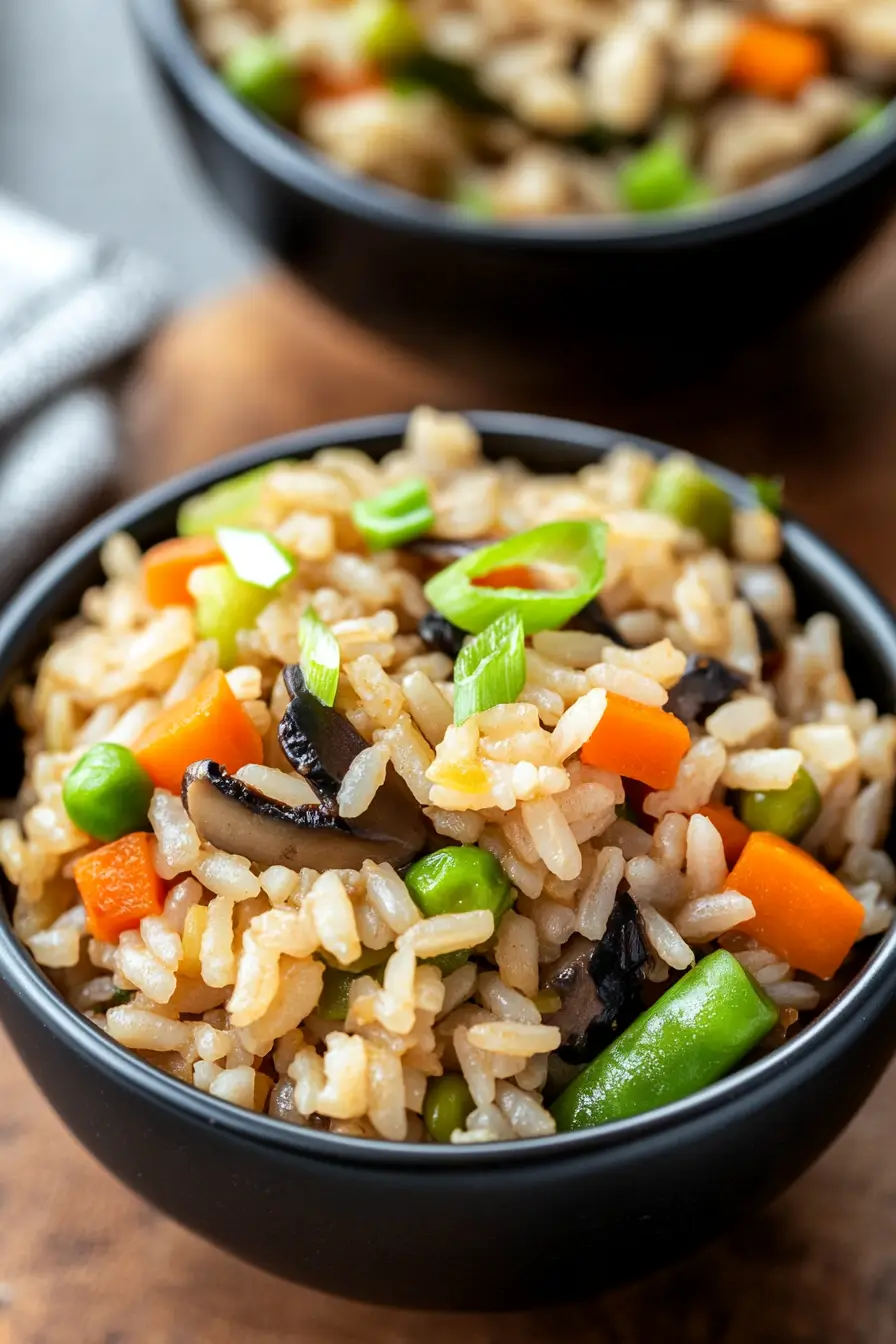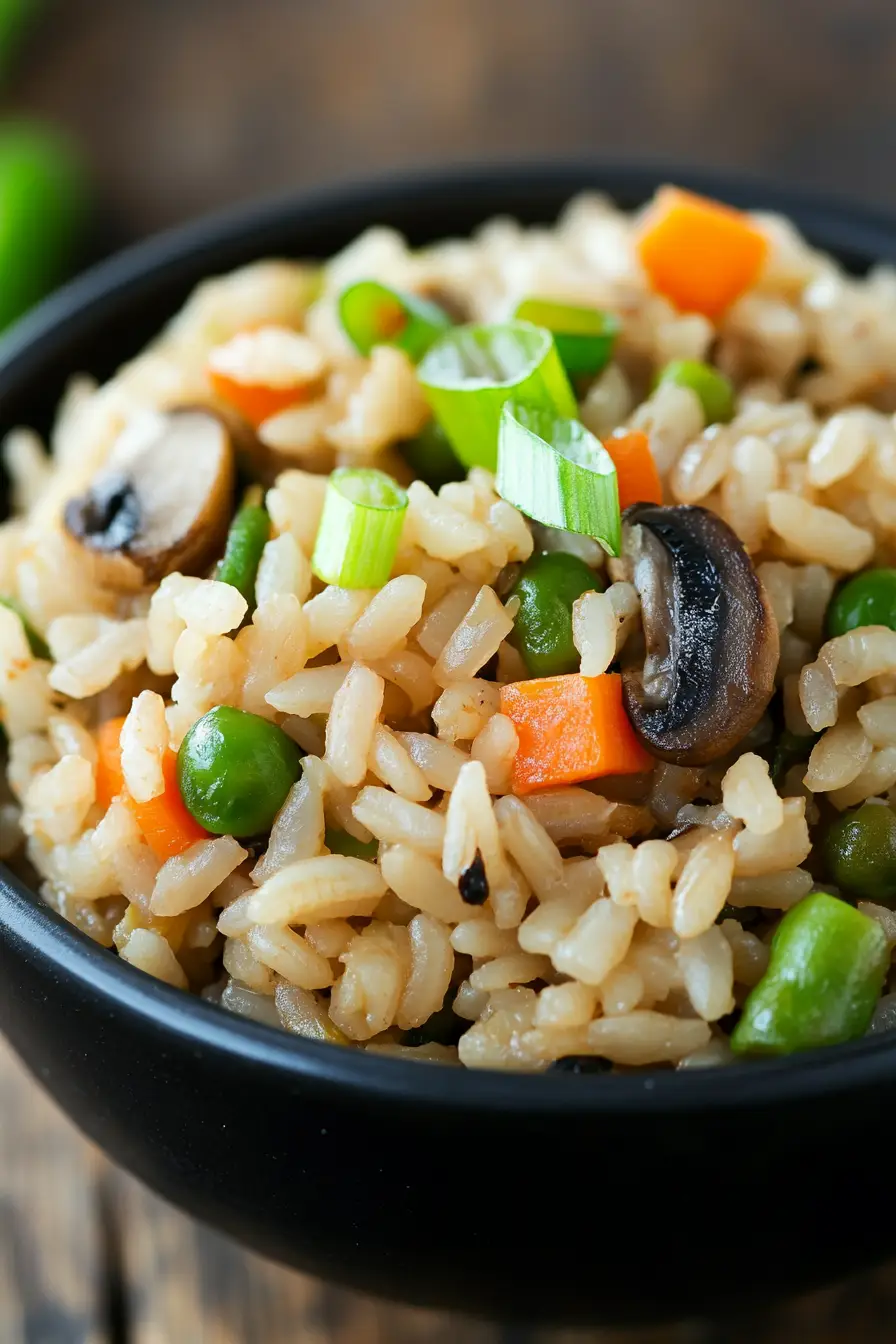You know, I used to think rice was just rice – dump it in a pot with some water and hope for the best. That’s how my mom made it, and honestly, it worked fine. But when my sister tried cooking it that way, we ended up with a gummy mess that stuck to the bottom of the pot.
Turns out, using a rice cooker isn’t just easier – it’s practically impossible to mess up. And adding vegetables right in there with the rice? It’s like getting a complete side dish without having to think about it. Plus, it’s one of those hands-off cooking methods that lets you focus on the rest of dinner without worrying about burning anything.

Why You’ll Love This Vegetable Rice
- One-pot convenience – Everything goes into the rice cooker at once – no extra pots and pans to wash, making cleanup a breeze.
- Nutritious and filling – This dish packs a variety of colorful vegetables right into your rice, making it an easy way to get more nutrients in your meal.
- Hands-free cooking – Just add the ingredients, press a button, and let your rice cooker do all the work while you focus on other things.
- Everyday ingredients – You’ll find most of these ingredients in your regular grocery store, and the Asian seasonings are common pantry staples that last a long time.
- Meal prep friendly – Make a batch and enjoy it throughout the week – it reheats beautifully and works great as a side dish or base for lunch bowls.
What Kind of Rice Should I Use?
Short-grain white rice is definitely the way to go for this recipe, though medium-grain can work in a pinch. Japanese-style rice varieties like Calrose or Koshihikari are perfect since they become slightly sticky when cooked, helping all those veggie pieces stick together nicely with each bite. Regular long-grain rice isn’t the best choice here since it stays separate and fluffy rather than sticky, which isn’t ideal for this dish. Just make sure to rinse your rice thoroughly under cold water until the water runs clear – this removes excess starch and helps prevent your rice from becoming mushy. If you’re having trouble finding short-grain rice at your regular grocery store, check out Asian markets where you’ll find several good options.

Options for Substitutions
This rice cooker recipe is pretty flexible and you can make several swaps based on what you have in your kitchen:
- Short-grain white rice: This is one ingredient I recommend not substituting since it’s the foundation of the dish. Other rice types like long-grain or brown rice need different water ratios and cooking times.
- Vegetables: The great thing about this recipe is you can swap the vegetables based on what you have. Try corn, peas, diced bell peppers, or broccoli florets. Just keep the total amount of vegetables similar to avoid throwing off the liquid ratio.
- Sake: If you don’t have sake, you can use dry white wine or Chinese rice wine. In a pinch, you can use 1 tablespoon rice vinegar mixed with 1 tablespoon water.
- Mirin: No mirin? Mix 1 tablespoon honey or sugar with 1/2 tablespoon water as a substitute. This will add the needed sweetness.
- Green onions: These can be replaced with chives or left out if you don’t have them. You could also use finely chopped regular onion tops.
Watch Out for These Mistakes While Cooking
The biggest mistake when making rice cooker vegetable rice is not rinsing the rice thoroughly beforehand – wash it 3-4 times until the water runs clear to remove excess starch and prevent a gummy texture. Another common error is lifting the rice cooker lid while cooking, which releases essential steam and can lead to unevenly cooked rice and vegetables. To get the timing right, add harder vegetables like carrots at the beginning with the rice, but wait until the last 5 minutes of cooking to add quick-cooking vegetables like cabbage and green onions to prevent them from becoming mushy. For the best flavor distribution, make sure to evenly distribute the liquid seasonings (soy sauce, sake, and mirin) over the rice before starting the cooker, and let the rice rest for 10 minutes after cooking is complete to allow the flavors to settle and the moisture to distribute evenly.

What to Serve With Vegetable Rice?
This flavorful rice dish works great as a side but can easily become the star of the meal with the right pairings. For a simple weeknight dinner, serve it alongside grilled chicken, fish, or tofu – the soy sauce and sake seasonings in the rice complement these proteins perfectly. If you want to keep things vegetarian, try adding a fried egg on top with an extra drizzle of soy sauce, or serve it with some crispy pan-fried dumplings on the side. For a complete Asian-inspired meal, pair it with some miso soup and a simple cucumber salad dressed with rice vinegar and sesame oil.
Storage Instructions
Keep Fresh: This veggie-packed rice stays good in the fridge for up to 4 days when stored in an airtight container. The flavors actually get better after a day as everything melds together! Just make sure to cool the rice completely before storing to prevent any unwanted moisture build-up.
Freeze: Rice with vegetables freezes really well! Portion it into individual servings in freezer-safe containers or bags and it’ll keep for up to 3 months. This is super handy for quick lunch prep or when you need a fast dinner option.
Warm Up: To bring your rice back to life, sprinkle a few drops of water over it and microwave until hot, stirring halfway through. You can also pan-fry it to make a quick fried rice – just add a splash of oil and heat it up in a wok or skillet. The vegetables might be a bit softer after reheating, but the taste will still be great!
| Preparation Time | 10-15 minutes |
| Cooking Time | 30-40 minutes |
| Total Time | 40-55 minutes |
| Level of Difficulty | Easy |
Estimated Nutrition
Estimated nutrition for the whole recipe (without optional ingredients):
- Calories: 600-700
- Protein: 12-15 g
- Fat: 5-10 g
- Carbohydrates: 130-150 g
Ingredients
For the rice and vegetables:
- 8 button mushrooms (thinly sliced)
- 10 green beans (trimmed and cut into 1-inch pieces)
- 2 cups short-grain white rice (I prefer Nishiki Premium)
- 1/4 cup shredded cabbage
- 1 small carrot (finely diced)
- 1/2 small onion (diced into 1/2-inch pieces)
For the seasoning:
- 1/2 tsp salt
- 3 tbsp soy sauce
- 1 1/2 tbsp mirin
- 2 tbsp sake
For the garnish:
- 3 green onions (thinly sliced)
Step 1: Rinse the Rice
Begin by placing 2 cups of Japanese rice into the rice cooker pot.
Rinse the rice by adding water and swirling it around with your hand, then draining the water.
Repeat this process until the water runs clear to remove excess starch.
Once rinsed, thoroughly drain the rice.
Step 2: Season the Rice
Add 3 tablespoons of soy sauce, 2 tablespoons of sake, 1.5 tablespoons of mirin, and 0.5 teaspoons of salt to the drained rice in the cooker pot.
Next, add water up to the 2 cups measuring line marked inside the pot.
This ensures the rice cooks with the right amount of moisture.
Step 3: Add Vegetables
Top the seasoned rice with the chopped vegetables: 1 small carrot, 1/4 cup shredded cabbage, 1/2 small finely chopped onion, 10 chopped green beans, and 8 chopped button mushrooms.
Avoid stirring the mixture; simply distribute the vegetables evenly over the rice.
Step 4: Cook the Rice
Place the pot into the rice cooker.
Close the lid securely and set the rice cooker to the plain (regular rice) setting.
Let the cooker do its work until the rice is perfectly cooked and all the flavors are absorbed.
Step 5: Fluff and Serve
Once the rice cooking cycle is complete, open the lid of the rice cooker.
Gently fluff the rice with a wooden or plastic spoon to mix the vegetables with the rice.
Serve the seasoned vegetable rice hot and enjoy your flavorful dish.

